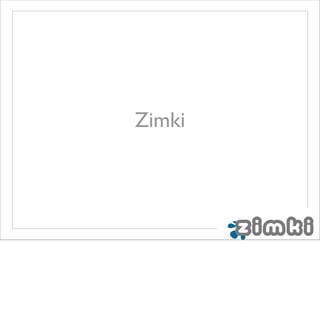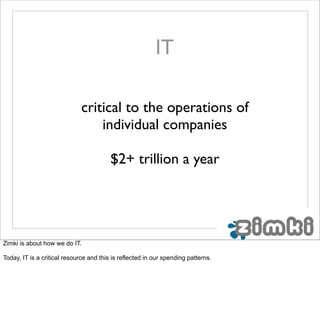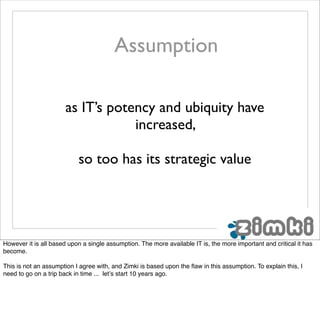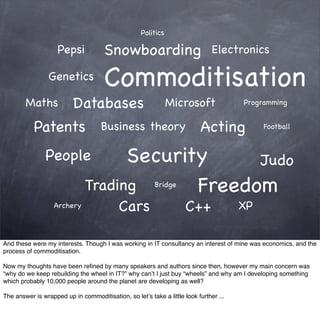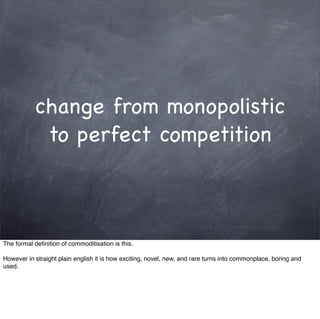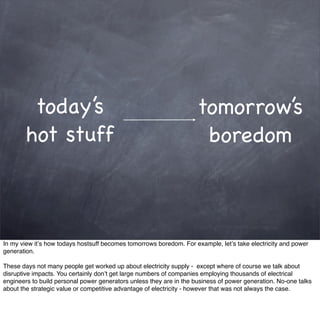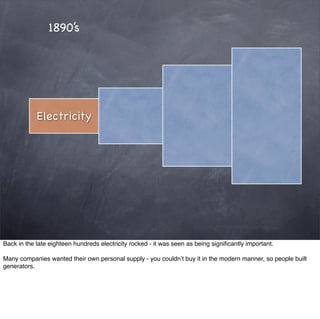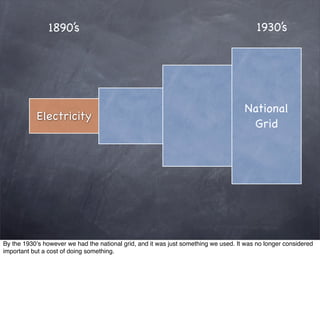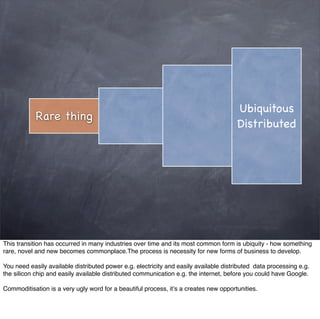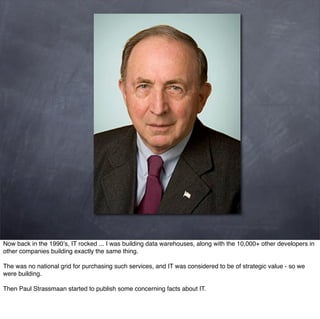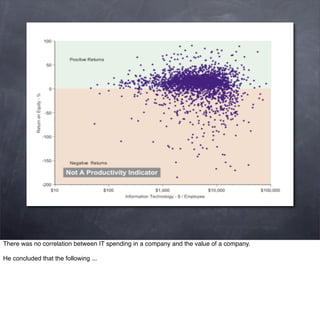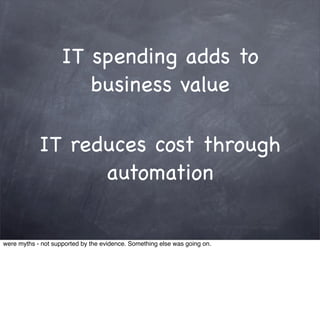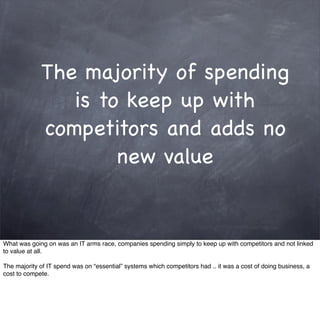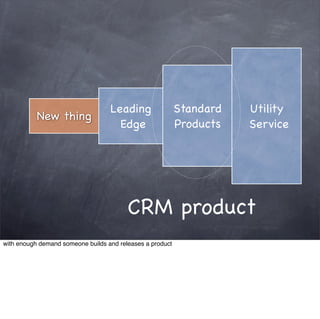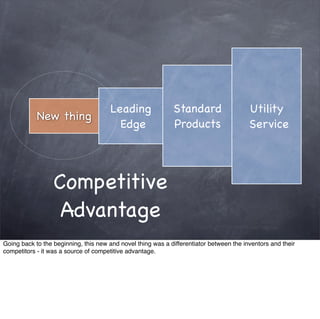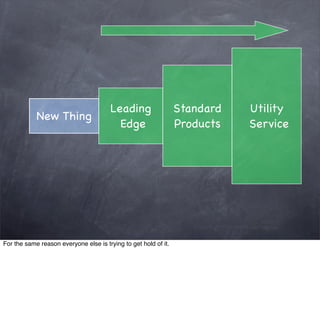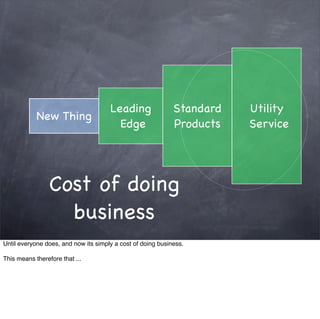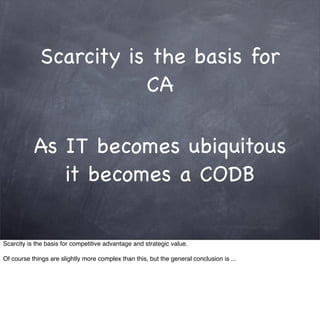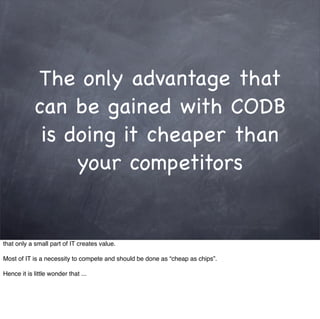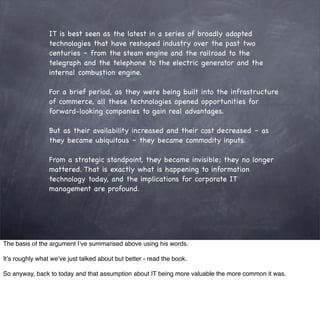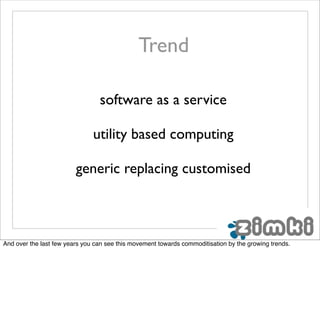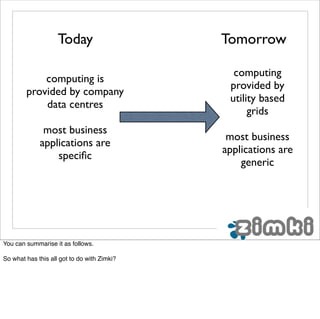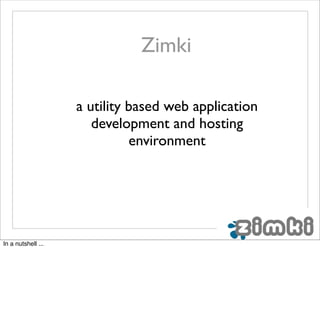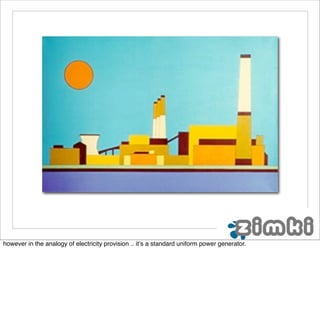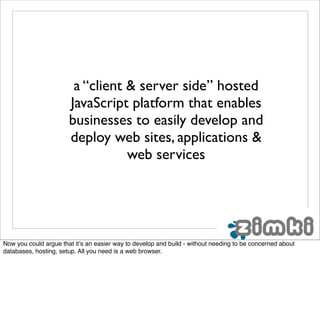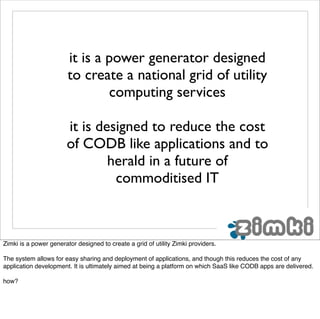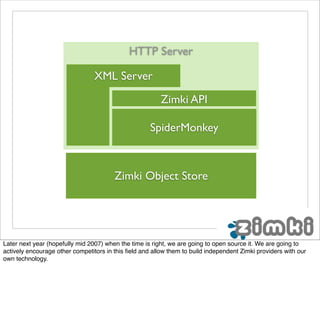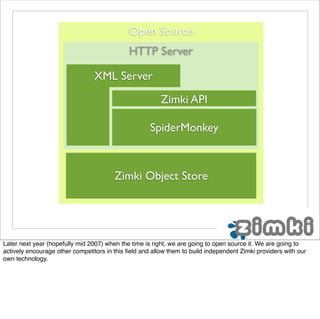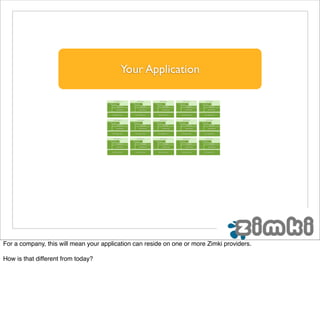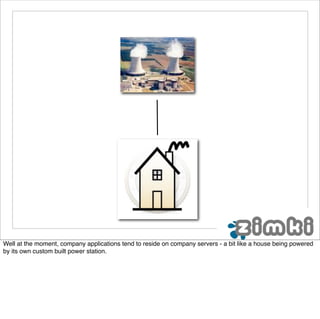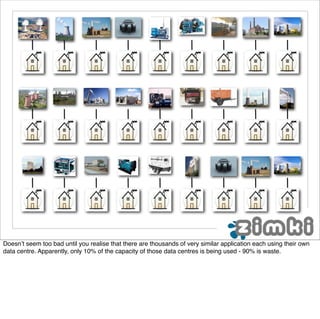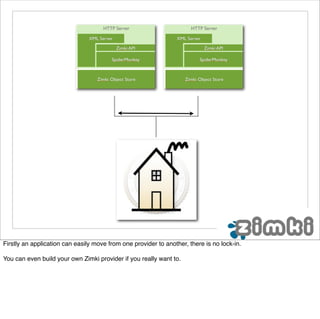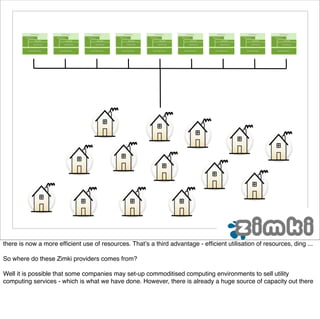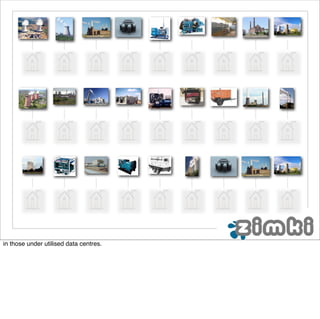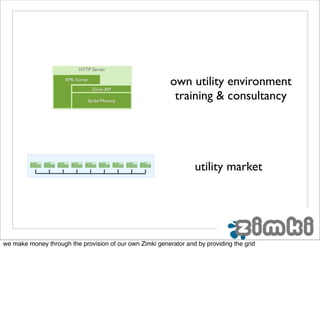Zimki 2006
- 1. Zimki
- 2. IT critical to the operations of individual companies $2+ trillion a year Zimki is about how we do IT. Today, IT is a critical resource and this is reflected in our spending patterns.
- 3. Common Wisdom strategic value used for competitive advantage Most people talk about the benefits that IT brings.
- 4. Assumption as IT’s potency and ubiquity have increased, so too has its strategic value However it is all based upon a single assumption. The more available IT is, the more important and critical it has become. This is not an assumption I agree with, and Zimki is based upon the flaw in this assumption. To explain this, I need to go on a trip back in time ... let’s start 10 years ago.
- 5. It’s 1996 ... these girls were hot.
- 6. I had hair ... honest.
- 7. Politics Pepsi Snowboarding Electronics Genetics Commoditisation Maths Databases Microsoft Programming Patents Business theory Acting Football People Security Judo Trading Freedom Bridge Archery Cars C++ XP And these were my interests. Though I was working in IT consultancy an interest of mine was economics, and the process of commoditisation. Now my thoughts have been refined by many speakers and authors since then, however my main concern was “why do we keep rebuilding the wheel in IT?” why can’t I just buy “wheels” and why am I developing something which probably 10,000 people around the planet are developing as well? The answer is wrapped up in commoditisation, so let’s take a little look further ...
- 8. change from monopolistic to perfect competition The formal definition of commoditisation is this. However in straight plain english it is how exciting, novel, new, and rare turns into commonplace, boring and used.
- 9. today’s tomorrow’s hot stuff boredom In my view it’s how todays hostsuff becomes tomorrows boredom. For example, let’s take electricity and power generation. These days not many people get worked up about electricity supply - except where of course we talk about disruptive impacts. You certainly don’t get large numbers of companies employing thousands of electrical engineers to build personal power generators unless they are in the business of power generation. No-one talks about the strategic value or competitive advantage of electricity - however that was not always the case.
- 10. 1890’s Electricity Back in the late eighteen hundreds electricity rocked - it was seen as being significantly important. Many companies wanted their own personal supply - you couldn’t buy it in the modern manner, so people built generators.
- 11. Electrical engineers were the hottest thing around
- 12. 1890’s 1930’s National Electricity Grid By the 1930’s however we had the national grid, and it was just something we used. It was no longer considered important but a cost of doing something.
- 13. Ubiquitous Rare thing Distributed This transition has occurred in many industries over time and its most common form is ubiquity - how something rare, novel and new becomes commonplace.The process is necessity for new forms of business to develop. You need easily available distributed power e.g. electricity and easily available distributed data processing e.g. the silicon chip and easily available distributed communication e.g. the internet, before you could have Google. Commoditisation is a very ugly word for a beautiful process, it’s a creates new opportunities.
- 14. Now back in the 1990’s, IT rocked ... I was building data warehouses, along with the 10,000+ other developers in other companies building exactly the same thing. The was no national grid for purchasing such services, and IT was considered to be of strategic value - so we were building. Then Paul Strassmaan started to publish some concerning facts about IT.
- 15. There was no correlation between IT spending in a company and the value of a company. He concluded that the following ...
- 16. IT spending adds to business value IT reduces cost through automation were myths - not supported by the evidence. Something else was going on.
- 17. IT spending adds to business value IT reduces cost through automation were myths - not supported by the evidence. Something else was going on.
- 18. The majority of spending is to keep up with competitors and adds no new value What was going on was an IT arms race, companies spending simply to keep up with competitors and not linked to value at all. The majority of IT spend was on “essential” systems which competitors had .. it was a cost of doing business, a cost to compete.
- 19. Leading Standard Utility thing New Thing Edge Products Service Now this also links to commoditisation. For example.
- 20. Leading Standard Utility thing New Thing Edge Products Service CRM Imagine the first ever CRM system. It proved useful, something which only one company had.
- 21. Leading Standard Utility thing New Thing Edge Products Service Consultants However if its useful then other companies will want it, and consultants quickly spread the technology and it becomes leading edge
- 22. Leading Standard Utility thing New Thing Edge Products Service CRM product with enough demand someone builds and releases a product
- 23. Leading Standard Utility thing New Thing Edge Products Service Pay per use CRM and eventually with enough of a market, a utility service appears.
- 24. Leading Standard Utility thing New Thing Edge Products Service Competitive Advantage Going back to the beginning, this new and novel thing was a differentiator between the inventors and their competitors - it was a source of competitive advantage.
- 25. Leading Standard Utility thing New Thing Edge Products Service Naturally, they seek to protect this.
- 26. Leading Standard Utility New Thing Edge Products Service For the same reason everyone else is trying to get hold of it.
- 27. Leading Standard Utility New Thing Edge Products Service Cost of doing business Until everyone does, and now its simply a cost of doing business. This means therefore that ...
- 28. Scarcity is the basis for CA As IT becomes ubiquitous it becomes a CODB Scarcity is the basis for competitive advantage and strategic value. Of course things are slightly more complex than this, but the general conclusion is ...
- 29. Cost of Competitive Advantage doing business That our industry is in a constant move from CA to CODB and most IT today is CODB - very little is CA. This also means ...
- 30. The only advantage that can be gained with CODB is doing it cheaper than your competitors that only a small part of IT creates value. Most of IT is a necessity to compete and should be done as “cheap as chips”. Hence it is little wonder that ...
- 31. the correlation between IT spending and company value would be weak. I believe the movement to ubiquitous IT and the inability to distinguish in many companies between CA / CODB & transitional IT is the cause of this. Two phenomenon have also accelerated this process - firstly the internet, and second open source. Take open source for example ...
- 32. Leading Standard Utility New Thing Edge Products Service open source by giving away new stuff, the open source movement have removed blocks such as vested interests and accelerated the commoditisation of IT. This is great news for the industry as a whole, just lousy for a vested interest. Now these ideas have been around for sometime and they’ve not been a popular subject in IT. However in 2003 - one individual clearly put such concepts on the map.
- 33. A Harvard based economist called Nicholas Carr. He subsequently published a book ...
- 34. that gave a clear, detailed and precise argument why IT was going through the process of commoditisation. Naturally, this wasn’t very popular with people who made money out of IT not being seen as a commodity - which was most of IT.
- 35. IT is best seen as the latest in a series of broadly adopted technologies that have reshaped industry over the past two centuries – from the steam engine and the railroad to the telegraph and the telephone to the electric generator and the internal combustion engine. For a brief period, as they were being built into the infrastructure of commerce, all these technologies opened opportunities for forward-looking companies to gain real advantages. But as their availability increased and their cost decreased – as they became ubiquitous – they became commodity inputs. From a strategic standpoint, they became invisible; they no longer mattered. That is exactly what is happening to information technology today, and the implications for corporate IT management are profound. The basis of the argument I’ve summarised above using his words. It’s roughly what we’ve just talked about but better - read the book. So anyway, back to today and that assumption about IT being more valuable the more common it was.
- 36. Assumption as IT’s potency and ubiquity have increased, so too has its strategic value The assumption would appear wrong ..
- 37. Reality as IT’s ubiquity has increased it has become a cost of doing business with little or no strategic value the reality being the reverse.
- 38. Trend software as a service utility based computing generic replacing customised And over the last few years you can see this movement towards commoditisation by the growing trends.
- 39. Today Tomorrow computing computing is provided by provided by company utility based data centres grids most business most business applications are applications are specific generic You can summarise it as follows. So what has this all got to do with Zimki?
- 40. Today Tomorrow computing computing is provided by provided by company utility based data centres grids most business most business applications are applications are specific generic Well Zimki is an environment designed to support this transition.
- 41. Zimki a utility based web application development and hosting environment In a nutshell ...
- 42. however in the analogy of electricity provision .. it’s a standard uniform power generator.
- 43. a “client & server side” hosted JavaScript platform that enables businesses to easily develop and deploy web sites, applications & web services Now you could argue that it’s an easier way to develop and build - without needing to be concerned about databases, hosting, setup. All you need is a web browser.
- 44. And we have examples of blogs to wikis to forums to weather apps which have been built on this.
- 45. you only pay for what you consume It is utility based - competitive, transparent and there is no capital investment required. Zimki provides this through economies of scale and managed demand and supply.
- 46. a cheaper & faster way of building and deploying web applications utility based and minimises risk In summary you could say this of Zimki and we’ve been doing this since early 2006. Well, if that is all we said .. we’d be wrong. The potential is much greater and was always planned to be.
- 47. it is a power generator designed to create a national grid of utility computing services it is designed to reduce the cost of CODB like applications and to herald in a future of commoditised IT Zimki is a power generator designed to create a grid of utility Zimki providers. The system allows for easy sharing and deployment of applications, and though this reduces the cost of any application development. It is ultimately aimed at being a platform on which SaaS like CODB apps are delivered. how?
- 48. HTTP Server XML Server Zimki API SpiderMonkey Zimki Object Store Later next year (hopefully mid 2007) when the time is right, we are going to open source it. We are going to actively encourage other competitors in this field and allow them to build independent Zimki providers with our own technology.
- 49. Open Source HTTP Server XML Server Zimki API SpiderMonkey Zimki Object Store Later next year (hopefully mid 2007) when the time is right, we are going to open source it. We are going to actively encourage other competitors in this field and allow them to build independent Zimki providers with our own technology.
- 50. Your Application For a company, this will mean your application can reside on one or more Zimki providers. How is that different from today?
- 51. Well at the moment, company applications tend to reside on company servers - a bit like a house being powered by its own custom built power station.
- 52. Doesn’t seem too bad until you realise that there are thousands of very similar application each using their own data centre. Apparently, only 10% of the capacity of those data centres is being used - 90% is waste.
- 53. There is a huge potential for economies of scale - to utilise that waste. And that is where Zimki comes in. When you build an application, you build it on the Zimki grid - no capex, no hosting centre needed ... just write and deploy and pay for what you use. What is the Zimki grid?
- 54. The Zimki grid contains multiple providers (at the moment it is just us) - hence the need to open source Zimki. Each Zimki provider adds computing resources in the grid for use by multiple applications. This has some huge advantages ...
- 55. Firstly an application can easily move from one provider to another, there is no lock-in. You can even build your own Zimki provider if you really want to.
- 56. BOOM! Secondly there is resilience against outages. The intension is too have hundreds of Zimki providers, providing a resilience which cannot be matched by any one company.
- 57. the trick here is to balance supply and demand more accurately than the current 90% waste, so whereas before each application had its own data centre.
- 58. there is now a more efficient use of resources. That’s a third advantage - efficient utilisation of resources, ding ... So where do these Zimki providers comes from? Well it is possible that some companies may set-up commoditised computing environments to sell utility computing services - which is what we have done. However, there is already a huge source of capacity out there
- 59. in those under utilised data centres.
- 60. By open sourcing Zimki we provide a mechanism for companies to sell unused capacity into the grid - money for nothing. That’s the fourth advantage, ding ...
- 61. and it is a competitive market in utility computing resources. Because applications can shift providers based on price and QoS for example. Ding ... that’s number five, competitive utility market. However zimki also allows the easy sharing and deployment of applications - so it is easy to release multiple copies of the same application or to build SaaS like apps.
- 62. e.g. several separate secure versions of an app can be created, allowing one type of application to be used by multiple different companies or SaaS like apps to be built.
- 63. Hence supporting the growth of generic SaaS like apps. Ding ... that’s number six. Obviously the app providers need to sell their services at above the price of the grid, and from our viewpoint the more the grid is used - the more we make. To give an idea - our company web site currently costs 68p per day on Zimki. There are other advantages like simplified development, ding .. no more setting up hosting environments or servers, ding ... and on and on.
- 64. Zimki making money by commoditisation of IT But basically Zimki is really about ... making money by commoditising IT and making developers lives easier.
- 65. own utility environment training & consultancy utility market we make money through the provision of our own Zimki generator and by providing the grid
- 66. No capital investment Reduced risk Simpler process Faster Revenue from waste the customers (i.e company with their own apps or companies selling SaaS apps) have a cheaper, low risk way of building and releasing apps. companies have also the potential to generate revenue from waste.
- 67. we make our money selling excess resources to those who need it we are the access point to a “national grid” of utility services in a nutshell, this is where we are going ...
- 68. thank you

